
Journal of Science and Technique - ISSN 1859-0209
49
APPLICATION OF LEAN CONSTRUCTION PRINCIPLES
AND SIMULATION FOR PERFORMANCE IMPROVEMENT
OF EARTHWORK ACTIVITIES IN CONSTRUCTION PROJECTS
ON OFFSHORE ISLANDS
Quang Nam Nguyen1, Trong Quang Vu1,*
1Institute of Techniques for Special Engineering, Le Quy Don Technical University
Abstract
The main objective of this study is to apply Lean Construction (LC) principles combined
with a discrete event simulation tool, namely EZStrobe, to improve the performance of
earthworks in construction projects on offshore islands. Based on the observation of the real-
world construction process and the collection of data on each activity, a simulation model of
the digging and hauling operations of coral sand is established and validated. The analysis
results of the real model indicate problems of resource shortage as well as congestion in the
construction process that caused delays and poor productivity. Subsequently, the three LC
principles are applied to the simulation model to enhance the construction process. The
analysis results from the Lean model, when are compared with the real model, show that the
waiting time of construction equipment is reduced by 70.2%, the cycle and total construction
time are reduced by 34.2% and 33.9%, respectively. As a result, productivity is significantly
enhanced with an increase of 51.3% and a savings of 16.8% in cost. LC principles, when
combined with the simulation tool, have demonstrated their effectiveness in reducing waste
and improving construction processes. This approach helps managers effectively manage
their plans and make informed decisions to enhance construction productivity.
Keywords: Lean Construction; discrete event simulation; EZStrobe; performance improvement.
1. Introduction
Earthwork is an essential activity in most construction projects on offshore islands
in Vietnam. The large amount of work makes this activity mainly dependent on heavy
construction equipment such as excavators, trucks and bulldozers. The geographical
distance and complex maritime climate conditions in Vietnam have caused many
obstacles in transporting equipment and fuel to the islands. On the other hand, the
construction time is limited by the tidal water levels and the frequent breakdown of
equipment also significantly affects the efficiency of the work. The above characteristics
can cause significant risks to productivity, progress and cost of earthwork activities.
Therefore, planning and optimizing the use of equipment fleet is very important to
* Corresponding author, email: vutrongquang@lqdtu.edu.vn
DOI: 10.56651/lqdtu.jst.v7.n02.877.sce

Section on Special Construction Engineering - Vol. 07, No. 02 (Dec. 2024)
50
achieve productivity efficiency. In fact, this issue is often neglected due to the lack of
experience in organization and management of the contractor. Furthermore, the lack of
appropriate management tools has also become a barrier to analyzing and selecting
optimal construction organization options. To address the aforementioned problem, this
research is conducted with the goal of providing a solution to apply Lean Construction
principles combined with discrete event simulation in improving productivity and
minimizing waste in earthwork activities.
Lean Construction (LC) is a powerful movement in the construction industry
worldwide. Essential features of LC method focus on improving processes, minimizing
waste, and delivering the maximum value to the client [1]. Numerous LC techniques and
tools have been developed over the past decade to manage construction projects. In
practice, testing a new technique in project management can be expensive and time
consuming. Currently, simulation programs are advancing rapidly, Computer modelling
and simulation are performed before the actual implementation in order to reduce the risk,
time, and cost involved. Modelling is a powerful tool which helps us in two important
ways. The first one is revealing shortages related to designing the system and the other
one is highlighting opportunities for improving the system performance. Therefore, a
simulation-based approach is a suitable method for applying LC principles to enhance
construction processes.
Many studies have been conducted to improve the performance of construction
activities by applying LC principles using simulation. Notable examples include concrete
pouring operations [1-4], reinforcement operations [5-7], brick work operations [7-9] and
earthwork operations [10]. However, a review of the literature shows that the application
of LC principles to improve earthwork operations is rarely studied. Subsequently, this
study was conducted to fill the gap and enrich the available knowledge in the field of LC.
In addition, a simulation program different from previous studies used in this study to
apply LC principles is the EZStrobe simulation. This is a simulation program with many
outstanding features in modeling and analyzing complex construction operations such as
earthwork operations.
2. Lean Construction principles and EZStrobe simulation
2.1. Lean Construction principles
Lean Construction is an approach towards designing production systems to
minimize the waste of materials and time in construction, in order to maximize benefits
to customers [7]. To achieve this goal, LC is implemented through the application of

Journal of Science and Technique - ISSN 1859-0209
51
various principles. In the scope of this study, three LC principles are applied and
described in the following paragraphs.
Flow production in processes: The flow of processes in a lean system is defined as
the movement of resources including: materials, human resources, equipment, and
information within the system [11]. This principle indicates that resources interacting with
activities in the system need to be circulated continuously, avoiding stagnation, so that
activities can proceed without interruption. This principle impacts bottlenecks in the
manufacturing system, which helps to minimize waiting time and shorten cycle time.
Implement the concept of pulling: Delays in material delivery are a common
problem in the construction industry, causing equipment and workers to wait, which leads
to reduce productivity and increase project duration. The pull principle aims to improve
coordination between upstream and downstream tasks through just-in-time delivery of
materials [11]. Pull describes a process in which downstream operations notify upstream
operations when they are ready to begin production, and the downstream resource
requirements must be provided immediately so that the process is not interrupted. On the
other hand, providing the downstream’s requirements earlier than needed will create
unnecessary inventories and it may lead to extra cost.
Minimize non-value-adding activities: Lean thinking divides the flow activities
in a process into Value-Adding (VA) and Non-Value-Adding (NVA) activities [5].
VA activities are activities that directly contribute to producing the final product and are
perceived as valuable by the customer. In contrast, NVA activities are activities that
consume resources, time or space but do not contribute to value creation for the product
needed by the customer [9]. Examples of NVA activities include equipment repair,
rework, transportation, and waiting.
2.2. EZStrobe simulation
EZStrobe is a discrete-event simulation system that uses STROBOSCOPE as its
simulation tool. This program serves as a simple but powerful general-purpose simulation
system, capable of modeling numerous complex construction operations. EZStrobe
operates based on extended and annotated Activity Cycle Diagrams (ACDs) and was
developed to function within Microsoft Visio. The basic modeling components of
EZStrobe are shown in Table 1.

Section on Special Construction Engineering - Vol. 07, No. 02 (Dec. 2024)
52
Table 1. Main components of the EZStrobe model [12]
Element
Description
Restriction
A Combi represents a constrained activity. Its
start will be triggered by the availability of
required resources.
A Combi can only follow
Queues, but be placed before
any other node except a
Combi.
A Normal represents an unconstraint activity. It
will start depending on the completion of
preceding activities.
A Normal can follow any
node other than a Queue, and
be placed before any node
except a Combi.
A Queue represents idle resources that are
stored for use in a succeeding Combi.
A Queue can follow any other
node other than a Queue and
precede only a Combi.
A Fork represents a probabilistic routing
element that triggers a branch selection to the
succeeding element.
A Fork typically follows a
Combi or Normal but can also
follow another Fork.
A Draw Link represents a connectivity between
different activities and queues.
-
Release Link represents a connectivity between
an activity to any other node except a Combi.
-
Branch Link represents a connectivity between
a Fork to any other node except a Combi.
-
3. A case study
The case study focuses on earthwork activities in a construction project on an
offshore island in Vietnam. During this process, a total of 800,000 m³ of coral sand is
excavated and transported. Table 2 provides information on the available equipment
related to the task. The flow chart of the actual earthwork activities and related equipment
is shown in Fig. 1.
Table 2. Details of equipment involved in earthwork activities for the project
No.
Equipment
Model
Quantity (pcs)
Capacity (m3)
1
Excavator
XCMG - XE600DK
6
2.6
2
Truck
TONLY - TLM50
12
20
3
Bulldozer
KMS - D65PX
1
5.5
Based on direct observation of the actual construction process, the earthwork
activities are organized as follows:
- The contractor organizes 6 routes for coral sand excavation, with 2 trucks arranged
to transport coral sand for each route.

Journal of Science and Technique - ISSN 1859-0209
53
- Temporary roads to the excavation sites are constructed for coral sand
transportation. The average transport distance is 1.2 km.
- At the dumping site, the contractor uses one bulldozer to backfill the coral sand.
The bulldozer driver is responsible for guiding the trucks to the dumping location. When
the volume of dumped soil is equivalent to 4 piles of coral sand, the bulldozer starts
working. The trucks will wait to dump until a position is available.
- During the implementation of tasks, construction equipment often breaks down
due to the construction conditions affected by the marine climate. The contractor uses one
repair team to fix equipment failures.
The research process is described as follows: First, it is necessary to evaluate the
actual construction process and identify the factors affecting the productivity. An
evaluation method based on simulation techniques is suitable for this purpose. A
simulation model that describes the actual earthwork activities is established using the
EZStrobe simulation program. Model validation is performed, and the results from the
model are evaluated. Next, LC principles are applied to the model, and a Lean model is
formed. Finally, the results between the Lean model and the real model are compared to
assess the impacts of LC principles.
Fig. 1. The flow chart of the actual earthwork activities.
4. Real world model establishment
4.1. Collect input data for simulation
Prior to performing the simulation, it is essential to determine an appropriate time
distribution for each activity. Based on time data collected from multiple observations of
the same activity, the authors collected a dataset including 50 samples for the duration of
each activity. Crystal Ball v11.2 software is employed to identify the distribution of time
for each activity, and the Kolmogorov-Smirnov test is applied to assess the distribution of
the collected data. The analysis results for each activity’s duration are presented in Table 3.
Load
Truck
Excavator
Truck
Haul
Truck
Soil Units Truck
Dump
Truck
Return
Push
Soil
Bulldozer
Soil BDZ
Wait
Load
Wait
Dump
Soil Pile

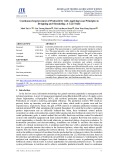

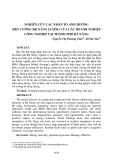

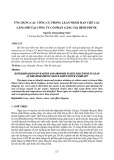

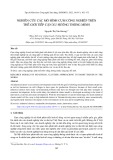


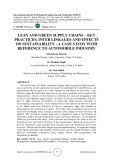


![Tối ưu hóa hiệu suất hệ thống: Bài thuyết trình [Chuẩn nhất]](https://cdn.tailieu.vn/images/document/thumbnail/2025/20251107/hiepdz2703@gmail.com/135x160/35941762488193.jpg)




![Bài giảng Quản trị chất lượng trong công nghiệp thực phẩm [chuẩn nhất]](https://cdn.tailieu.vn/images/document/thumbnail/2025/20250805/vijiraiya/135x160/637_bai-giang-quan-tri-chat-luong-trong-cong-nghiep-thuc-pham.jpg)

![Đề cương bài giảng Kỹ năng hoạt động công nghiệp [mới nhất]](https://cdn.tailieu.vn/images/document/thumbnail/2025/20250715/kimphuong1001/135x160/76971752564028.jpg)


![Bài giảng Kỹ thuật điều độ trong sản xuất và dịch vụ [mới nhất]](https://cdn.tailieu.vn/images/document/thumbnail/2025/20250630/dcbaor/135x160/13121751251866.jpg)


